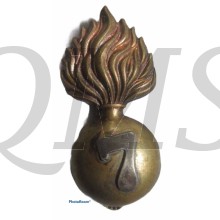Cap badge 7th city of London Battalion
The 7th (City of London) Battalion of the London Regiment was a volunteer unit of the British Army from 1860 until 1961. Recruited from London working men, it sent volunteers to the Second Boer War, saw extensive service on the Western Front during World War I, and defended the UK as a searchlight regiment during World War II.
At the outbreak of war, 32 Searchlight Bn was deployed with HQ and 329 Company at Framlingham, 328 Company at Bildeston and 330 Company at Saxmundham. The battalion was under the command of 41 (London) AA Brigade in 2 AA Division The equipment was modern 90-centimetre searchlights with early pattern sound locators.
The first months of the war were quiet, but on the night of 7/8 June 1940 the battalion was the first searchlight unit to bring down an enemy aircraft, the crew of a Heinkel He 115 coastal reconnaissance aircraft being dazzled by a detachment at Rendelsham and crashing nearby.
On the night of 18/19 June a strong night air raid crossed the coast at Harwich and flew through the battalion area. Many of the aircraft were illuminated and seven were shot down by Spitfires, one flown by Sqn-Ldr Adolph Malan, even though the day fighters had no other detection equipment.
In July 1940, the battalion was transferred from 41 AA Bde to 6 AA Brigade, which was responsible for defending Royal Air Force airfields in Essex; the brigade soon afterwards came under 6 AA Division. The battalion's companies were controlled by the Operations Room at RAF Debden.
In 1940 all the RE searchlight units were transferred to the Royal Artillery (RA), and the battalion became 32nd (7th City of London) Searchlight Regiment, RA (TA) in August 1940; Sappers were retitled Gunners, and Companies became Batteries.
The Blitz
In September 1940 the main night-bombing campaign against London and the cities of the United Kingdom (The Blitz) began, and cooperation between searchlights and RAF night-fighters as well as AA guns became increasingly important. Anti-Aircraft Command was rapidly increased in size. Existing regiments provided cadres to help train new units: 32 S/L Regiment sent three such cadres to establish new batteries, and between September and November 1940 ran a Regimental Training Centre at Brandeston Hall to provide initial training for 400 new recruits. In July 1941, 32 S/L regiment was joined by 562 Battery, formed by a cadre from the regiment and recruits of 1941. The new battery completed its training at Brettenham Hall.
In late 1941 the battalion began to receive Radar-equipped 90-cm searchlight projectors to replace sound locators. These required relocation of some sites to obtain best results. Early in 1942 the regiment shifted some of its sites southwards, including parts of Essex, with 328 Battery based a Felixstowe, 330 Battery atManningtree, from where it covered Shotley Royal Naval Training Establishment (HMS Ganges) and the Harwich Naval Base, and 562 Battery covering Colchesterand Chelmsford. These three batteries came under the control of RAF North Weald Operations Room. Regimental HQ also moved to Manningtree. Part of 328 Battery's duties was to provide 'Canopy' for RAF Martlesham Heath, where a cone of searchlights over the airfield assisted homing aircraft. This duty ended when the US Eighth Air Force took over Martlesham Heath. The regiment also provided 'Canopy' for RAF Wattisham in the spring of 1941.
The radar equipment, and larger 150-centimetre searchlights, gave increasingly successful results with Heavy AA guns and in cooperation with the new generation of RAF night fighters. 32 S/L Regiment usually cooperated with 85 Squadron flying Havocs and later Mosquitos from RAF Hunsdon and 29 Sqn and the New Zealand 488 Sqn flying Mosquitos from RAF Bradwell Bay. Low-flying attacks by German fighter-bombers were often engaged by Light AA guns and by the searchlight detachments themselves with twin Vickers machine guns.
As the air defence battle was being won, men began to be withdrawn from AA Command to provide manpower for 21st Army Group in the Invasion of Normandy. Many roles such as plotters, drivers and telegraphists in 32 S/L Regiment were taken over by women of the Auxiliary Territorial Service (ATS), freeing able-bodied men for other duties, while 562 Battery was wholly disbanded in early 1944.
From July to August 1944 the regiment was actively engaged in assisting operations against V-1 flying bombs, many of those crossing the East Anglian coats having been launched from aircraft over the Dutch Coast.
After VE Day, 32 S/L Regiment staffed release centres at Oxford and Reading, Berkshire to administer the demobilisation process. Regimental HQ, which had been reduced to a cadre at Derby as a holding unit, was placed in suspended animation in 1946.


